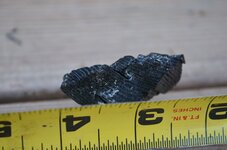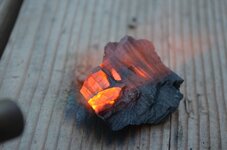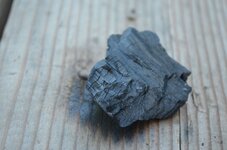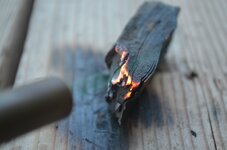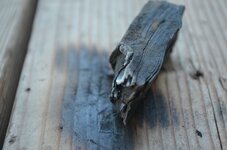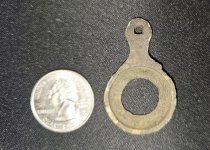BosnMate
Gold Member
- Sep 10, 2010
- 6,916
- 8,441
- Detector(s) used
- Whites MXT, Whites DFX, Whites 6000 Di Pro
- Primary Interest:
- Other
Experimenting With 6000 Year Old Charcoal
I tried to light the charcoal on fire using a propane torch. The charcoal wouldn't burn, so it's been mineralized to a point.
For those who haven't seen my previous post regarding the charcoal buried in pumice on the upper reaches of the north Umpqua river, check out this link and you will be up to speed regarding what we are talking about.
http://www.treasurenet.com/forums/my-daily-snapshot/436507-6000-year-old-charcoal.html#post4227294
I did a little research on the eruption of Mt. Mazama, and in a nut shell, here's what I found out.
“Until 1937 it was thought that the Mazama eruption had occurred about 25,000 years ago. Discovery of several archeological sites beneath pumice deposited by the mountain provided conclusive evidence that man was residing in the area at the time of the eruption. The most famous excavations were made by a team led by L.S. Cressman at the Fort Rock Cave, where sandals made of sagebrush bark were found. These and several other types of artifacts were found under a layer of Mazama ash, which serves as an important marker layer in buried soils throughout the northeast fall zone. As a result, the estimated date of the eruption was revised to sometime between 4,000 and 10,000 years ago.
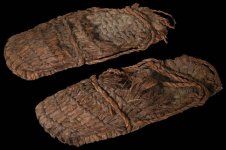
These sagebrush bark sandals were found at Fort Rock Cave.
The range of 6,000 years was subsequently refined when three investigators collected a charcoal sample west of the park for radiocarbon dating in 1949. A road cut on Muir Creek along state highway 230 had exposed charred trees embedded in thThe pumice of the glowing-avalanche deposit is easily distinguished from that which earlier fell from the air. Whereas the airborne pumice is well sorted (i.e., all the particles are approximately the same size at a given point), the avalanche material consists of lumps of pumice of varying size, set in a matrix of very fine, dust-like pumice fragments. Some of the largest lumps of pumice have been found at the extreme limits of the avalanche deposits. The airborne pumice is a yellowish tan color; the avalanche pumice is usually pinkish tan. The pink coloration is the result of stains from the iron-bearing gases that it retained after coming to rest. As the glowing avalanche rushed down the stream drainage, it encountered thick forests, though timberline was then at a lower elevation than at present. The force of the avalanche bowled over even the largest trees and swept them along in the turbulent cloud. As the avalanche came to rest, the buried trees were carbonized by the intense heat retained by the pumice fragments and gases. Lumps of charcoal are found scattered through the deposit, and are exposed in road cuts near Clearwater Falls, Lemolo Lake, and White Horse Falls. This charcoal has been identified as remnants of pine and fir trees like those presently growing in the area."
The yellow highlight is the area we are talking about near Clearwater Falls.
The link will take you to the quoted article.
A "New" Date for Mount Mazama's Climactic Eruption - Vol. 23, 1992
"There is evidence that man watched the fiery holocaust in the area—at least from a distance. Charred Indian sandals have been found beneath the airborne pumice deposit near Paisley, some 80 miles east of the Crater Lake region. It is likely that some forest animals were trapped by the speeding glowing avalanche, but no remains have yet been uncovered in the Diamond Lake area.
Each day the streams remove a little more of the veiling mantle; and each new road cut exposes some new facet of the hidden past.
http://en.wikipedia.org/wiki/Mount_Mazama" Paisley caves are south east of the mountain, Fort Rock cave is about the same distance northeast.
And this is another link you might be interested in.
The Geologic History of the Diamond Lake Area (Geologic History of the Diamond Lake Area)
I don't want to give anyone the idea that the charcoal is plentiful along the hiway cuts, because it isn't. The pumice easily erodes and uncovers more all the time. Just because there is charcoal the last time you were there is no guarantee that it will be there the next trip. I've driven up the hiway a number of times and seen none at all. This photo is typical of what you might find.
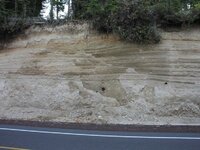
The first time I stopped and picked up some charcoal, it was more like a rock, heavy and dense, and no black rubs off. But it is also crumbly, and flakes apart along the growth rings.
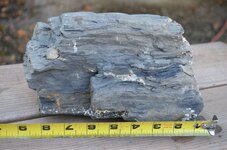
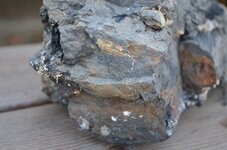
The above pictures were my first charcoal, heavily mineralized, but I've changed my mind about it being petrified, because I think if it was petrified it would be solid stone that could be cut and polished, and even though this is still heavy and dense like a rock, it still flakes apart following the growth rings of the tree.
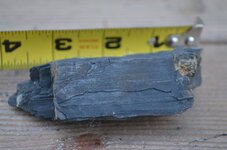
This smaller piece is off the larger one first shown, note how it broke off along the growth ring.
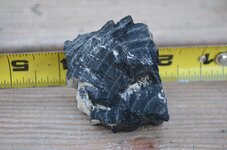
This small piece I picked up on the last trip up there. Note the wide growth rings. This charcoal is feather light, but also apparently mineralized, because it wouldn't burn.
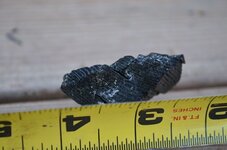
This is the other piece I picked up, note the very tight growth rings on this one, which is also feather light.
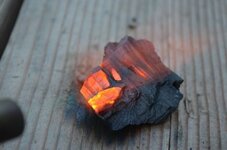
I used a propane torch trying to get the latest charcoal I found to burn.
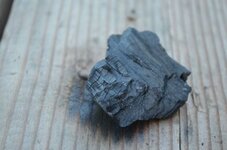
But had no luck.
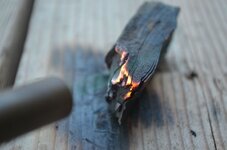
So I tried to get the first heavy dense one to burn using the torch, and it never glowed any more than what you are seeing here.
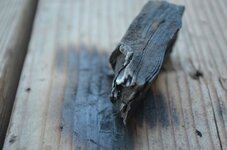
No luck at all on this one, but you can see how a couple of growth rings are separating. On of those flaked off, so I picked it up and held it in my fingers while holding one end in the torch flame. It was like holding a nail in your fingers, only the part in the fire glowed red, but it burned my fingers to the point I dropped it, and the glow stopped as soon as it was out of the flame.
It's also interesting to note that to the east of the mountain, they have found what they call "wells." These are holes that intire trees were buried standing, but they didn't become charcoal, for the most part they decayed away. Except in one well the wood was preserved, and they were able to find out a lot from the growth rings on that tree. I forget where I read that though, so I can't give a link.
I tried to light the charcoal on fire using a propane torch. The charcoal wouldn't burn, so it's been mineralized to a point.
For those who haven't seen my previous post regarding the charcoal buried in pumice on the upper reaches of the north Umpqua river, check out this link and you will be up to speed regarding what we are talking about.
http://www.treasurenet.com/forums/my-daily-snapshot/436507-6000-year-old-charcoal.html#post4227294
I did a little research on the eruption of Mt. Mazama, and in a nut shell, here's what I found out.
“Until 1937 it was thought that the Mazama eruption had occurred about 25,000 years ago. Discovery of several archeological sites beneath pumice deposited by the mountain provided conclusive evidence that man was residing in the area at the time of the eruption. The most famous excavations were made by a team led by L.S. Cressman at the Fort Rock Cave, where sandals made of sagebrush bark were found. These and several other types of artifacts were found under a layer of Mazama ash, which serves as an important marker layer in buried soils throughout the northeast fall zone. As a result, the estimated date of the eruption was revised to sometime between 4,000 and 10,000 years ago.

These sagebrush bark sandals were found at Fort Rock Cave.
The range of 6,000 years was subsequently refined when three investigators collected a charcoal sample west of the park for radiocarbon dating in 1949. A road cut on Muir Creek along state highway 230 had exposed charred trees embedded in thThe pumice of the glowing-avalanche deposit is easily distinguished from that which earlier fell from the air. Whereas the airborne pumice is well sorted (i.e., all the particles are approximately the same size at a given point), the avalanche material consists of lumps of pumice of varying size, set in a matrix of very fine, dust-like pumice fragments. Some of the largest lumps of pumice have been found at the extreme limits of the avalanche deposits. The airborne pumice is a yellowish tan color; the avalanche pumice is usually pinkish tan. The pink coloration is the result of stains from the iron-bearing gases that it retained after coming to rest. As the glowing avalanche rushed down the stream drainage, it encountered thick forests, though timberline was then at a lower elevation than at present. The force of the avalanche bowled over even the largest trees and swept them along in the turbulent cloud. As the avalanche came to rest, the buried trees were carbonized by the intense heat retained by the pumice fragments and gases. Lumps of charcoal are found scattered through the deposit, and are exposed in road cuts near Clearwater Falls, Lemolo Lake, and White Horse Falls. This charcoal has been identified as remnants of pine and fir trees like those presently growing in the area."
The yellow highlight is the area we are talking about near Clearwater Falls.
The link will take you to the quoted article.
A "New" Date for Mount Mazama's Climactic Eruption - Vol. 23, 1992
"There is evidence that man watched the fiery holocaust in the area—at least from a distance. Charred Indian sandals have been found beneath the airborne pumice deposit near Paisley, some 80 miles east of the Crater Lake region. It is likely that some forest animals were trapped by the speeding glowing avalanche, but no remains have yet been uncovered in the Diamond Lake area.
Each day the streams remove a little more of the veiling mantle; and each new road cut exposes some new facet of the hidden past.
http://en.wikipedia.org/wiki/Mount_Mazama" Paisley caves are south east of the mountain, Fort Rock cave is about the same distance northeast.
And this is another link you might be interested in.
The Geologic History of the Diamond Lake Area (Geologic History of the Diamond Lake Area)
I don't want to give anyone the idea that the charcoal is plentiful along the hiway cuts, because it isn't. The pumice easily erodes and uncovers more all the time. Just because there is charcoal the last time you were there is no guarantee that it will be there the next trip. I've driven up the hiway a number of times and seen none at all. This photo is typical of what you might find.

The first time I stopped and picked up some charcoal, it was more like a rock, heavy and dense, and no black rubs off. But it is also crumbly, and flakes apart along the growth rings.


The above pictures were my first charcoal, heavily mineralized, but I've changed my mind about it being petrified, because I think if it was petrified it would be solid stone that could be cut and polished, and even though this is still heavy and dense like a rock, it still flakes apart following the growth rings of the tree.

This smaller piece is off the larger one first shown, note how it broke off along the growth ring.

This small piece I picked up on the last trip up there. Note the wide growth rings. This charcoal is feather light, but also apparently mineralized, because it wouldn't burn.

This is the other piece I picked up, note the very tight growth rings on this one, which is also feather light.

I used a propane torch trying to get the latest charcoal I found to burn.

But had no luck.

So I tried to get the first heavy dense one to burn using the torch, and it never glowed any more than what you are seeing here.

No luck at all on this one, but you can see how a couple of growth rings are separating. On of those flaked off, so I picked it up and held it in my fingers while holding one end in the torch flame. It was like holding a nail in your fingers, only the part in the fire glowed red, but it burned my fingers to the point I dropped it, and the glow stopped as soon as it was out of the flame.
It's also interesting to note that to the east of the mountain, they have found what they call "wells." These are holes that intire trees were buried standing, but they didn't become charcoal, for the most part they decayed away. Except in one well the wood was preserved, and they were able to find out a lot from the growth rings on that tree. I forget where I read that though, so I can't give a link.
Attachments
Last edited:


